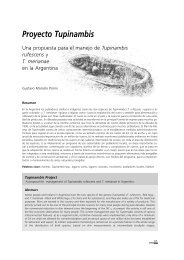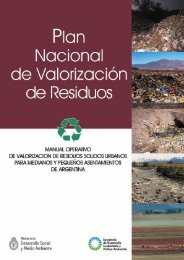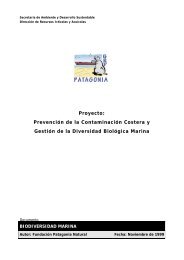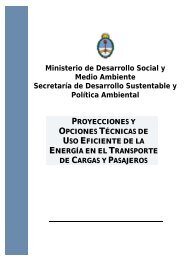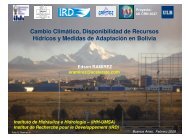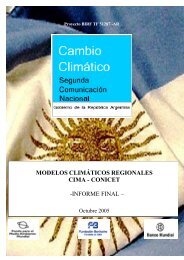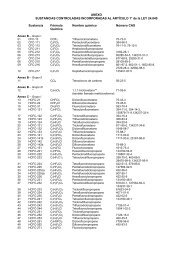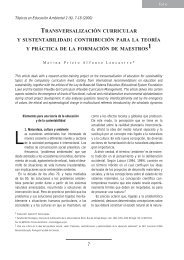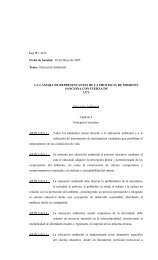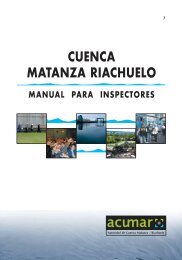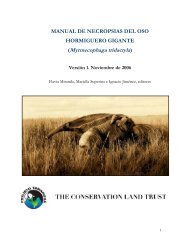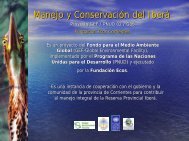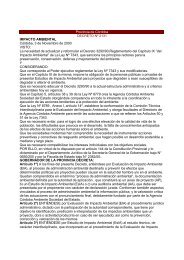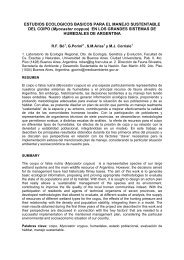reflexiones sobre educación ambiental ii - Secretaria de Ambiente y ...
reflexiones sobre educación ambiental ii - Secretaria de Ambiente y ...
reflexiones sobre educación ambiental ii - Secretaria de Ambiente y ...
Create successful ePaper yourself
Turn your PDF publications into a flip-book with our unique Google optimized e-Paper software.
50DE LA HERENCIA COTIDIANA AL TESORO PERDIDO: NUEVOS DESAFÍOS EN LA EDUCACIÓN AMBIENTALPARA LA CONSERVACIÓN DE LA BIODIVERSIDAD5. La articulación <strong>de</strong> la EA a programas integrales <strong>de</strong> conservación y uso sostenible <strong>de</strong> la biodiversidad.Para ello la EA <strong>de</strong>berá funcionar como puente entre las diferentes activida<strong>de</strong>s humanasy los programas <strong>de</strong> conservación <strong>de</strong> la biodiversidad <strong>de</strong> tal manera <strong>de</strong> orientarlas en función<strong>de</strong> la sostenibilidad <strong>ambiental</strong>, la salud y la armonía.Estas i<strong>de</strong>as representan una base preliminar que pue<strong>de</strong> permitir evaluar y reorientar los programaseducativos en función <strong>de</strong> un enfoque social <strong>de</strong>l ambiente. Este cambio <strong>de</strong> enfoque se hace másurgente a medida que se amplía la brecha entre los <strong>de</strong>seos expresados y los logros obtenidos.Si queremos, armonizar la relación entre las personas y la biodiversidad, será necesario prestarcada vez más atención a la dimensión humana <strong>de</strong> la conservación <strong>ambiental</strong>, y así evitar convertirel patrimonio biológico en un tesoro perdido.BIBLIOGRAFÍABROWN R., RENNER M. Y HALWEIL B. (1999) Signos Vitales. Las Ten<strong>de</strong>ncias que Guiarán NuestroFuturo. Informe <strong>de</strong>l Worldwatch Institute. GAIA Proyecto 2050 - Bakeaz. Madrid. 165 pp.EHRENFELD, D. (1988) Why put a value on biodiversity. pp. 212-216. En: Biodiversity. Wilson EO(Ed.) National Aca<strong>de</strong>my Press. Washington. 521 pp.GREIG, S.; PIKE, G.; SELBY, D. (1991) Los Derechos <strong>de</strong> la Tierra. Como si el Planeta RealmenteImportara. Editorial Popular. Madrid. 96 pp.LABONTE, R. (1996) Community empowerment and leisure. Journal of Leisurability 23(1): 4-20.LEFF, E. (1996) Conocimiento y Educación Ambiental. Formación Ambiental 7(17) 9pp.PADUA, S.: TABANEZ, M.; SOUZA, MDG.; HOEFFEL, J.L. (1999) Participação: um elemento-chavepara envolvimiento comunitário. Rev. Educ. Ensino - USF Bragança Paulista 4(2): 75-84.QUINN, M.S. y SCOTT, JR. (1997) Of Mega-Malls and Soft-Shelled Turtles: Deep Ecological Educationto counter Homogeneity. Trumpeter. 14.2 URL: http://www.icaap.orgSAUVÉ, L. (1998) La educación <strong>ambiental</strong>: entre la mo<strong>de</strong>rnidad y la postmo<strong>de</strong>rnidad: en busca <strong>de</strong>un marco <strong>de</strong> referencia educativo integrador. Tópicos en Educación Ambiental 1(2): 7-25.SHIELDS, K. (1994) In the Tiger's Mouth. An Empower Gui<strong>de</strong> for Social Action. New Society Publishers.Vermont. 172 pp.SHIVA, V. (1993) Monocultures of the mind. Trumpeter. 10 (4) URL: http://www.icaap.orgSOULÉ, M. (1988) Mind in the biosphere; mind of the biosphere. pp. 465-469. En: Biodiversity.Wilson EO (Ed.) National Aca<strong>de</strong>my Press. Washington. 521 pp.THOMASHOW, M. (1998) The ecopsychology of global environmental change. Presentado en elColoquio Virtual: The Future of Environmental Education in a Postmo<strong>de</strong>rn World?http://www.ec.gc.ca/eco/educationTRÉLLEZ, E.; WILCHES-CHAUX, G. (1999) Educación para un Futuro Sostenible en América Latinay el Caribe. Interamer 67 Serie Educativa. Secretaría General <strong>de</strong> Organización <strong>de</strong> EstadosAmericanos. Washington. 122 pp.VAN MATRE, S. (1974) Acclimatizing. A personal and reflective approach to a natural relationship.American Camping Association. Martinsville. 225 pp.WILCHES-CHAUX (1999) ¿Qué tiene que ver la biodiversidad con nuestra vida cotidiana? RedIbero <strong>de</strong> la CEC-IUCN.



